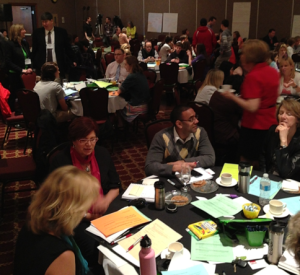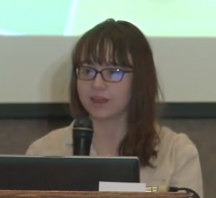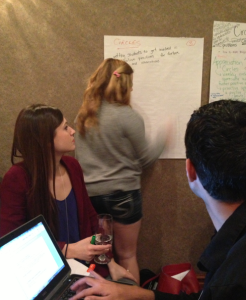The following article discusses two 2013 symposia, one held in the town of Cobourg in southern Ontario, Canada, another in Thunder Bay in the northern part of the province, both funded by the Ontario Ministry of Education to develop restorative practices in schools and the community. Bruce Schenk, director of IIRP Canada said, “Restorative practices is not just being done by a school board [district] here and there, but is a potentially recognized and supported approach right across the province.” RP is not confined to Ontario. In a companion piece, an elementary school teacher in British Columbia on the west coast of Canada, who recently attended an IIRP Canada professional development event near Vancouver, describes the specific ways she uses restorative practices in her classrooom.
On May 2, 2013, a group of restorative practitioners, who are all involved in implementing restorative practices at the systems level in their respective school districts, organized an event in Ontario, Canada, that brought together 300 students, teachers, school staff and administrators from across the southern part of the province to discuss restorative practices in a restorative environment. The Restorative Practices Symposium, as it was called, used circle processes to give everyone present a voice in a series of conversations aimed at building new connections across districts and to identify both what is working and where improvements can be made. Everything discussed during the day was recorded and has now been analyzed and included in a qualitative research report that will be used to guide schools across the province in furthering their own restorative practices implementation efforts.
 Photo by Sam Kourakis
Photo by Sam Kourakis
It all started with a team of 14 frontline restorative practitioners from 10 district school boards, mostly in southern Ontario, who have been meeting two-to-three times per year over the past two years to discuss the successes and challenges of continued restorative practices implementation in their respective districts. Calling themselves the “The Restorative Practice Consortium,” they ran their meetings essentially as a professional learning community. They used a circle format, where each person would have a chance to speak – and just as important, listen – to one another about their work. The goal was to provide mutual support and to share their considerable knowledge and experience with each other.
Stan Baker, the group’s nominal leader and spokesperson – who insists that each participant plays an essential role* – is the Safe, Caring and Restorative Schools Resource Teacher at Kawartha Pine Ridge District School Board, located about an hour’s drive east of Toronto. “I love the meetings,” he said. “From the beginning they were completely full of electricity with all kinds of ideas going around. Someone would say something they did and someone else would say, ‘Really! How does that work?’ Every time we got together everyone came away with something.” Another member, according to Baker, touted the group as “Phenomenal! I don’t have to convince anybody about the effectiveness of restorative practices. We just talk about how it’s going in our schools.”
In May 2012 Baker mentioned the group’s work to someone at the provincial Ministry of Education, who responded by suggesting that Baker and the Consortium plan an event to do on a larger scale what the group was already doing for themselves and the ministry would fund it. The Consortium rose to the challenge to develop a structure that would embed restorative principles and produce something that could be built upon afterwards. So instead of proposing a standard conference, the group decided to structure the day as a kind of professional learning group experience for all participants, to give attendees an opportunity to share their own successes and challenges and to learn from one another. They also built in a research component to help establish guidelines for what a fully restorative school would “look like, sound like and feel like.”
IIRP Canada has trained and continued to work with many of the people and schools that organized and attended the Symposium. Bruce Schenk, director of IIRP Canada, was pleased to see that the focus went way beyond discipline, focusing instead on "relational based learning" and "getting the relationships right in school and class." When you do that, he said, people feel connected, included, they have voice and they are respected. "That’s the best possible context for learning."
After a year of planning, the Symposium took place at a hotel in the town of Cobourg, Ontario, about 60 miles (100 kilometers) east of Toronto, with nearly 300 people from 14 school districts in attendance, including students, administrators, teachers, counselors and other school staff. Like a traditional conference, the symposium opened with a keynote address, but everything about the day was special.
To begin with, a student rather than a teacher, administrator or expert delivered the keynote address. Hannah Elsworth, an 18-year-old from the Kingston area, spoke about her personal challenges, including her family life and mental health issues. She continually referenced the various restorative practices she had been involved with in her school and the positive impact these had on her. Elsworth received a standing ovation for her moving speech, which set the tone for the day and led right into interactive sessions.
 18-year-old student Hannah Elsworth delivers the keynote address.The first round of morning circle discussions were organized on an open space principle. People proposed ideas and joined in round-table discussions that interested them about various ways that restorative practices were being applied in different areas. During the second session, students grades six and up worked together to discuss “restorative practices, engagement, student voice and choice.” The adults stayed together but grouped with new people to discuss “Core Principles and Concepts” of restorative practices, including engagement, inclusiveness, accountability, relationships, fairness, empathy and other concepts. All the comments made by each group were recorded on paper, and mutually agreed upon ideas were then inputted directly into Google documents created to facilitate the qualitative research gathering process. Besides contributing to the final research report, these responses are being used to develop a rubric that schools might use to assess how restorative they are in these areas and spotlight places for improvement.
18-year-old student Hannah Elsworth delivers the keynote address.The first round of morning circle discussions were organized on an open space principle. People proposed ideas and joined in round-table discussions that interested them about various ways that restorative practices were being applied in different areas. During the second session, students grades six and up worked together to discuss “restorative practices, engagement, student voice and choice.” The adults stayed together but grouped with new people to discuss “Core Principles and Concepts” of restorative practices, including engagement, inclusiveness, accountability, relationships, fairness, empathy and other concepts. All the comments made by each group were recorded on paper, and mutually agreed upon ideas were then inputted directly into Google documents created to facilitate the qualitative research gathering process. Besides contributing to the final research report, these responses are being used to develop a rubric that schools might use to assess how restorative they are in these areas and spotlight places for improvement.
During the afternoon session, the focus was on establishing qualitative research guidelines based on the PrevNet Model of Healthy Relationships, a well-respected research framework in Canada that works in the areas of safe schools, bullying prevention and the importance of strong relationships for student success, which the organizers believe to be consistent with the restorative framework. The standards include social-emotional intelligence; skills, knowledge and understanding; social architecture and strategies; and supports. For this portion of the day participants were divided into three streams — staff, administration and students. This gave each group a chance to discuss in private with their peers their own unique perspectives on system-wide restorative practices implementation, and it gave them the opportunity to share things they might not feel comfortable sharing in mixed groupings. Questions were posed in each topic area. On social and emotional intelligence, for instance, students responded to a two-part prompt: “When I am respected even in a difficult situation, I’m more likely to…” and “When I feel blamed or judged, I am more likely to…” Teachers and staff were asked, “Are there some students that restorative practices works better with than others? What qualities do they have? What students doesn’t it work as well for?” Administrators discussed, “What qualities would you identify in staff that you would describe as ‘restorative’ in their practice or approach?” Analysis of these responses have also been included in the final report.
 Photo by Sam KourakisDr. Shannon Moore, associate professor in the Department of Child & Youth Studies at Brock University, who conducted a literature review, helped frame the research component for the day and prepared the final report, commented, “What I deeply valued [about the symposium] was that there were individuals from the Ministry of Education, school administrators, superintendents, teachers, principals and a lot of young people with a good range of age. Everybody was in this large room sitting at round tables. We moved around, sat with people we didn’t know, broke into different groups. Just the experience of being in that conference reflected the spirit of restorative practices, the sense of valuing voice and a deconstructing of that hierarchy we always find ourselves in, not only in schools but in other institutions.”
Photo by Sam KourakisDr. Shannon Moore, associate professor in the Department of Child & Youth Studies at Brock University, who conducted a literature review, helped frame the research component for the day and prepared the final report, commented, “What I deeply valued [about the symposium] was that there were individuals from the Ministry of Education, school administrators, superintendents, teachers, principals and a lot of young people with a good range of age. Everybody was in this large room sitting at round tables. We moved around, sat with people we didn’t know, broke into different groups. Just the experience of being in that conference reflected the spirit of restorative practices, the sense of valuing voice and a deconstructing of that hierarchy we always find ourselves in, not only in schools but in other institutions.”
In September the Consortium held a half-day follow up to provide a preliminary report on the data and get input into the final report. Three representatives — a staff, student and administrator — from each of the 14 school districts, were invited to attend. The final report will be sent to the Safe Schools branch of the Ministry of Education and to superintendents and principals of all the schools involved in the symposium. In the future, the group also hopes to be able to tie successful RP implementation to statistics on student achievement, a goal that was also articulated by administrators at the symposium.
Al Wray, the Safe Schools Coordinator for Keewatin-Patricia District School Board, is the only consortium member from the northwest of Ontario. He joked, “We were invited, the third cousins up in the Appalachians.” Wray has been helping implement restorative practices in his district for six years. He said, “I now have all those connections down there [in southern Ontario]. They can look and come to see what it looks like and feels like here. I can also send teachers down to see what they’re doing.” Wray said he brought teachers with him to the symposium in Cobourg. “It makes people feel part of something bigger, that it’s not just a passing fad. There’s a bigger, broader global movement. That energizes people. Many small flames make a big fire.”
Wray provides another special link between northern and southern Ontario as a participant at the 2nd Annual Symposium on Restorative Practices held in the northwestern Ontario city of Thunder Bay in April 2013. Titled “On the Path to a Restorative Community” and organized by Charles Bishop, an education officer for the Lakehead District School Board based in Thunder Bay, this Symposium was also funded by the Ministry of Education. It brought together eight district school boards, some with previous experience in restorative practices, but others newer to the concept or only using restorative practices responsively rather than in a “whole-school” context. IIRP Canada restorative practices training was also offered following the Symposium. “We began hoping for 100 people and ended up with 230,” Bishop said. “We’re pretty excited about that. Interest has grown exponentially over the past couple years.”
Restorative justice first gained prominence in the Thunder Bay area through its use by community groups. Bishop said restorative practices came to the schools as an outgrowth of Thunder Bay’s drug strategy, following the idea that restorative practices could be used to address drug issues in schools. Afterwards, schools also realized that restorative practices offered other benefits for the school community.
Wray said, “Restorative justice began with community service agencies, child and family services and the city department of social services. The city then brought restorative practices to schools. Now that they’re getting embedded there the trend seems to be to make sure everyone is working together in common to see that restorative practices becomes a citywide movement.”
The symposium drew representatives from the justice and mental health fields as well as the Thunder Bay city government and community. Bishop said the city is planning to use restorative practices in its summer and other youth programs and is looking to use circle processes as a part of its poverty-reduction strategy. A number of community groups are also looking to use restorative practices to build community relationships.
IIRP Canada’s Bruce Schenk attended both the northern and southern symposium, and he came away feeling both excited about what has happened as well as hopeful for the future. He said, “In Ontario, schools have been doing this [restorative practices] for the last 10 to 15 years. This reflects a more mature part of the restorative journey, but it continues to unfold. We aren’t anywhere near where it’s going to be!”
*Restorative Consortium Members include:
Stan Baker, Kawartha Pine Ridge DSB; Ruth Bell, Toronto DSB; Kendra Godin-Svoboda, Durham DSB; Susan Howard, Hastings Prince Edward DSB; Jan Kielven, York Region DSB; Mike O’Neill, Durham Catholic DSB; Shawn Quigley, Limestone DSB; Jim Reilly, Algonquin Lakeshore Catholic DSB; Shelley Steele, Hastings Prince Edward DSB; Karen Stoker, Peterborough Victoria Northumberland Clarington Catholic DSB; Judy Tetlow, Limestone DSB; Steve Young, York Region DSB.
Read the final report, Restorative Practices in Ontario Schools: Findings & Recommendations, by Dr. Shannon Moore, Director of the Centre for Women’s and Gender Studies, Associate Professor of Child and Youth Studies, January 2014. Prepared for the Ontario Ministry of Education Safe and Accepting Schools Branch, Prepared by Dr. Shannon Moore in cooperation with Stan Baker, Jan Kielven & The Restorative Practices Consortium.
